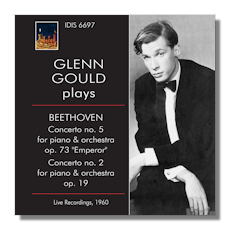
The Internet's Premier Classical Music Source
Related Links
- Beethoven Reviews
- Latest Reviews
- More Reviews
-
By Composer
-
Collections
DVD & Blu-ray
Books
Concert Reviews
Articles/Interviews
Software
Audio
Search Amazon
Recommended Links
Site News
 CD Review
CD Review
Ludwig van Beethoven

Live Recordings, 1960
- Piano Concerto #2 in B Flat Major, Op. 19 *
- Piano Concerto #5 in E Flat Major "Emperor", Op. 73
Glenn Gould, piano
* Detroit Symphony Orchestra/Paul Paray
Buffalo Philharmonic Orchestra/Josef Krips
Istituto Discografico Italiano IDIS6697
Even Glenn Gould's strongest admirers will admit two things; he was weird, and his Beethoven performances were especially so. That doesn't mean they aren't often compelling. But Gould's best Beethoven is either so weird that it amazes (his collaboration with Stokowski in the studio "Emperor") or so musical that it still sounds weird (his solo Lizst/Beethoven Symphonies). These mediocre live takes are neither, and I imagine that the pianist himself would hate them for various reasons. While hardly bad in the sense that they are perfectly acceptable versions for their era, that's not why we listen to these artists.
The "Emperor" leads off, with some hilariously prominent timpani throughout. I confess that I often put on new discs for review before bed; if I fall asleep, it's generally not good. But I couldn't have slept through this if I wanted to. Krips' Beethoven was never as old-fashioned (read: slow) as many of his contemporaries, and is in any event a known and respected quantity. It is not the most exciting, however, and the veteran conductor convinces neither his soloist nor orchestra to do anything truly special. Given the personality and flair of his one-off with Stokowski, the rather plain-Jane interplay proves disappointing. Also, a horribly mashed chord at the start of the concluding Rondo would never have been approved in a studio setting. The Buffalo players do not seem especially inspired on this occasion, timpanist aside. Nor does Gould play with his customary individuality, which ultimately leaves us with a rather uninspired take.
The Second Concerto with Paray is less disappointing, but no less uninteresting. Again, Gould's Columbia recording is really quite fine, and readily available. Live versions from the CBC suffer from poor sound, but appeal due to congenial collaborations with the pianist's fellow Canadians. In his finest efforts, Paul Paray was nothing short of an underrated genius. Here, he is simply dull. Consider the sharply-etched frameworks that Mercury label-mate Doráti was providing at the same time period, and there really is no comparison. And as fine as Paray's Detroit recordings are, they reveal an orchestra probably best recorded under studio conditions. To make a long story short, this is a rather heavy-handed and drab affair. IDI provides simply adequate transfers and no liner notes. I was initially very excited for this issue, but it certainly adds up to less than you might expect.
Copyright © 2015, Brian Wigman





















